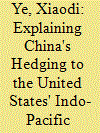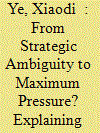| Srl | Item |
| 1 |
ID:
174405


|
|
|
|
|
| Summary/Abstract |
How China responds to the United States' Indo-Pacific strategy has become a crucial question for both policymakers and academics. The existing literature primarily focuses on how and why the United States, Japan, Australia, and India have promoted the Indo-Pacific concept and how this concept has imposed strategic pressure on China's national security. However, China's changing and complex attitudes and strategic responses to the Indo-Pacific concept have largely been overlooked. This article analyzes China's response from the perspective of a hedging strategy. It argues that while confronting the expanding range of containment, which is the crux of the Indo-Pacific strategy, China has applied a hedging strategy from two interrelated perspectives. In responding to the United States, the Chinese government adheres to the nonalliance principle and upgrades its China-Russia strategic partnership to resist the security pressure produced by the Indo-Pacific strategy. In responding to peripheral countries, China has adopted a reassurance approach to create a cooperative incentive for peripheral countries, particularly those that have security relations with the United States.
|
|
|
|
|
|
|
|
|
|
|
|
|
|
|
|
| 2 |
ID:
188942


|
|
|
|
|
| Summary/Abstract |
How do changes in US Taiwan policy play out? What is the logic behind these changes? To address these questions, existing studies have formulated four schools of explanation, providing valuable theoretical insights. However, these studies have obvious problems with unidirectional dichotomy and thus fail to identify a causal mechanism explaining the long-term trajectory of US Taiwan policy. This article conducts a re-typology of US Taiwan policy to break the traditional strategic ambiguity–clarity dichotomy by establishing three key indicators and argues that the orientation of US China policy and Taiwan’s US policy are the two major factors triggering changes. By conceptualizing and operationalizing the two independent variables as engagement-oriented, coopetition-oriented, containment-oriented, and hedging/bandwagoning/binding, this article develops a systemic theoretical framework to demonstrate how the US Taiwan policy transits between strategic clarity, maximum pressure, partial strategic clarity, between partial strategic clarity and strategic ambiguity, strategic ambiguity, and controlling the pro-independent forces. This article conducts empirical studies by reviewing the transition of US Taiwan policy under different presidencies in post–Cold War era to demonstrate how the theoretical framework works in realpolitik.
|
|
|
|
|
|
|
|
|
|
|
|
|
|
|
|